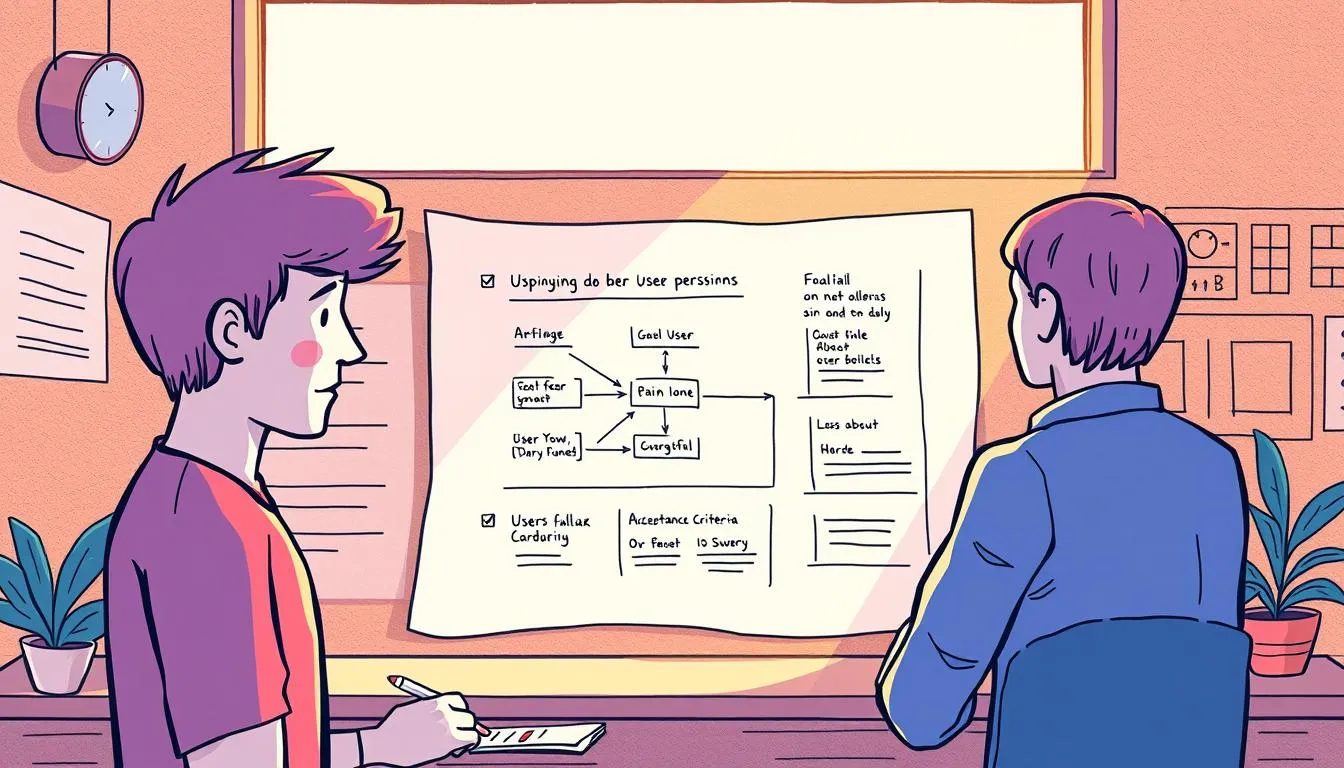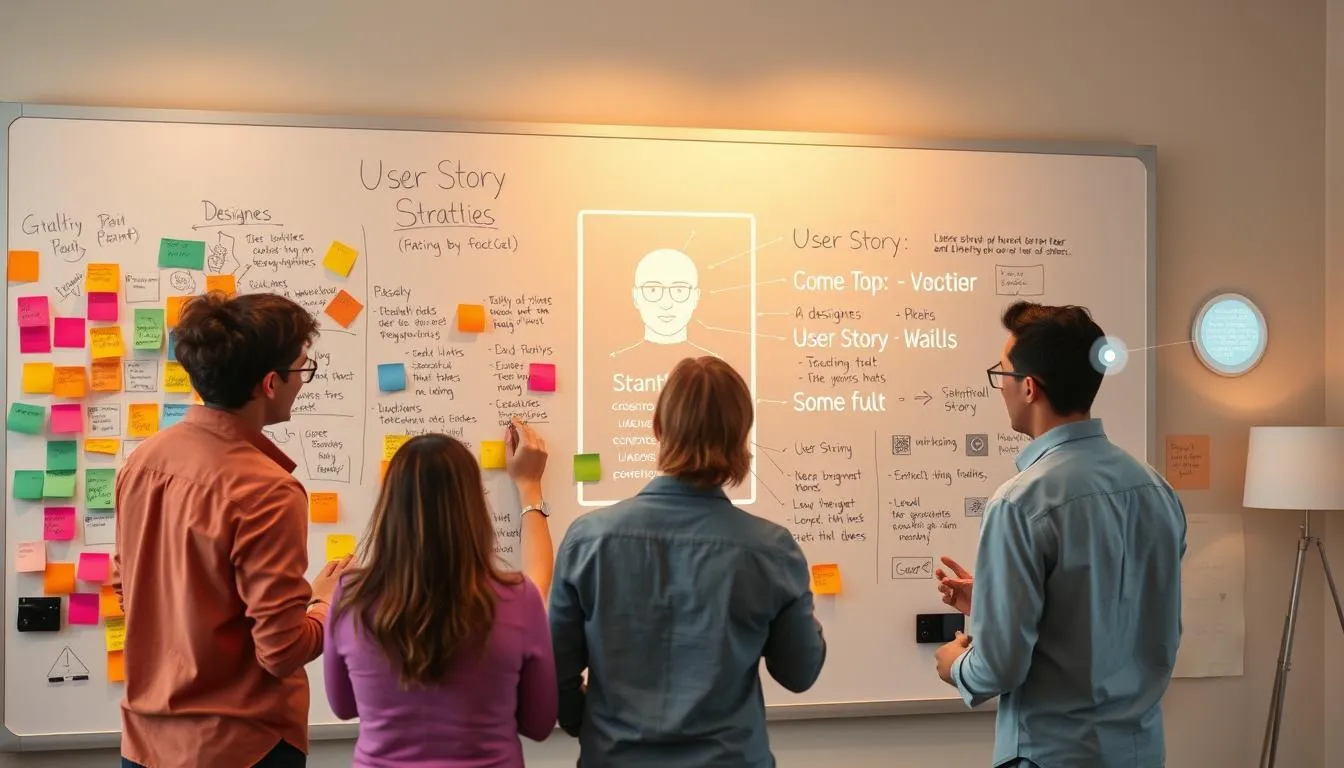“Imagination is the discovering faculty… It is that which penetrates into the unseen worlds around us.” — Ada Lovelace’s timeless insight reminds us that creativity and technology have always been partners in progress. Today, that partnership is reshaping how teams build products that resonate with real needs.
Imagine a tool that helps teams turn vague ideas into clear, actionable plans. Modern development workflows now blend human expertise with advanced systems to craft narratives that capture what customers truly want. This isn’t about replacing creativity—it’s about amplifying it.
Agile teams and product leaders face constant pressure to deliver value quickly. Traditional methods often lead to bottlenecks or missed details. Now, structured frameworks powered by intelligent tools help maintain consistency while preserving the human touch. The result? Faster alignment with business goals and fewer overlooked requirements.
This guide will show you how to enhance collaboration, streamline brainstorming, and produce precise narratives that drive results. Let’s explore how blending strategic thinking with cutting-edge solutions creates stories that inspire action.
Key Takeaways
- Intelligent tools boost efficiency without sacrificing creativity
- Structured frameworks help teams overcome creative blocks
- Consistency improves when combining human insight with technology
- Clear narratives align development with business objectives
- Modern approaches reduce planning time while increasing precision
Understanding User Stories and Their Importance
Every great product begins with understanding what people truly need. At its core, this process relies on clear communication between teams and those they serve. That’s where structured frameworks come into play.

Definition and Key Components
A user story acts like a compass for development teams. It answers three questions: Who benefits? What action occurs? and Why does it matter? For example: “As a shopper, I want saved payment options so checkout takes less time.” This format keeps everyone focused on real-world value.
These stories work best when they’re short and specific. They avoid technical jargon, making them easy for all stakeholders to grasp. By prioritizing customer goals over system details, teams build features that solve actual problems.
The Role of Acceptance Criteria in Agile
Think of acceptance criteria as the finish line for each story. They list measurable conditions like AI Rapid Prototyping: Streamlining confirmation emails within 2 minutes”* or “Payment methods display security badges.” Clear benchmarks prevent misunderstandings during sprints.
These criteria also foster collaboration. Developers know exactly what to build, testers verify outcomes, and clients see tangible results. When teams align around shared standards, projects move faster—and deliver what customers truly need.
The Foundations of a Successful User Story
Behind every feature that users love lies a well-structured blueprint built on collaboration and precision. Three proven frameworks help teams transform scattered ideas into focused narratives that drive results.

Frameworks: PAVA, 4C, and INVEST
The PAVA framework breaks stories into four pillars:
- Persona: Identifies specific user roles (“busy parents,” not “users”)
- Action: Uses active verbs like “filter” or “schedule”
- Value: Connects tasks to business goals like increased retention
- Acceptance: Defines measurable success markers
The 4C method turns stories into team playbooks. Cards standardize formats, Conversations gather stakeholder insights, Confirmation sets testable outcomes, and Context links to broader objectives.
| Framework | Focus | Key Elements |
|---|---|---|
| PAVA | Structure | Persona-driven value chain |
| 4C | Collaboration | Dialogue + documentation |
| INVEST | Quality | Testable, standalone stories |
Capturing User Needs Effectively
Great story creation starts with listening. Combine these approaches:
- Analyze support tickets for recurring pain points
- Map user journeys to spot hidden frustrations
- Host workshops with cross-functional teams
One e-commerce team increased feature adoption by 40% after using behavioral data to refine checkout stories. They discovered users abandoned carts when address fields lacked autofill—a detail traditional surveys missed.
These methods help teams generate user stories that balance speed with depth. By blending structure with real-world insights, you create narratives that developers can build and customers will use. Learn more about AI-Powered Google Sheets Automation:.
Exploring AI user story generation
Transforming raw ideas into actionable plans requires precision and speed—qualities modern development teams achieve through intelligent systems. These solutions analyze patterns in customer behavior while maintaining the nuance of human insight.
Accelerating Narrative Development
Advanced systems handle repetitive tasks like formatting and persona matching. For example, a banking app team reduced planning time by 65% when their tool automatically converted customer interviews into prioritized features. The secret? Structured templates that apply frameworks like INVEST while leaving room for creative adjustments.
These platforms excel at spotting trends humans might miss. One travel company discovered passengers wanted real-time luggage tracking by analyzing 12,000 support tickets. Their tool highlighted this need across multiple data sources, leading to a feature used by 78% of customers.
| Aspect | Manual Process | Automated Approach |
|---|---|---|
| Speed | 2-3 stories/hour | 50+ stories/hour |
| Data Analysis | Sample-based | Full dataset review |
| Formatting Consistency | 70% adherence | 98% adherence |
| Hidden Insights | Manual detection | Pattern recognition |
Teams maintain control through editable outputs. A healthcare software group combined generated narratives with clinician feedback to create patient portals that reduced appointment no-shows by 33%. The blend of machine efficiency and human expertise delivers results faster than either method alone.
Step-by-Step Guide to Generating User Stories Using AI
Creating clear development roadmaps starts with smart preparation. Follow this six-stage approach to transform scattered ideas into structured plans that teams can execute.

Defining Your Objective and Context
Start by naming the exact feature needing attention. Is it a payment gateway? A progress tracker? Specify the functionality and its purpose. Next, feed the system details about who’ll use it and why. Include:
- Primary personas (e.g., “first-time parents managing budgets”)
- Three key pain points they face
- Desired outcomes measured in time saved or errors reduced
Enhance Your Product with AI UX Analysis Insights delivery team used this method to cut app navigation time by 42%. They focused on busy cooks needing one-click recipe ingredient ordering.
Crafting Precise Prompts for Better Results
Clear instructions yield useful outputs. Compare these approaches:
| Aspect | Effective Prompt | Ineffective Prompt |
|---|---|---|
| Specificity | ”Create 3 stories for nurses tracking vaccine inventory" | "Make some medical stories” |
| Outcome Focus | ”Ensure 15-second prescription lookup" | "Improve medicine features” |
| Formatting | ”Use INVEST criteria with acceptance tests" | "Write stories quickly” |
Review initial outputs against your project’s goals. Add measurable criteria like “Show order confirmations within 5 seconds.” For existing narratives, use tools to generate user stories that fill gaps in clarity or scope.
Always refine with team input. A fintech group reduced revision cycles by 60% when developers and designers jointly polished machine-generated drafts. This blend of speed and human insight keeps projects aligned with real needs.
Essential Tools for AI-Powered User Story Generation
Choosing the right resources can transform how teams build product roadmaps. Let’s examine solutions that balance cost, functionality, and workflow compatibility.
Free vs Premium Solutions
Budget-friendly options work well for small teams. Chatbots like ChatGPT help draft initial concepts using simple prompts. Specialized platforms like Easy User Story Generator offer templates for structured outputs.
Enterprise teams often prefer integrated systems. Jira AI Assist connects directly with sprint boards, while Azure DevOps AI automates backlog updates. These paid tools reduce manual data entry by 80% in some cases.
| Tool Type | Examples | Best For | Limitations |
|---|---|---|---|
| Free Chatbots | Claude, Bard | Rapid prototyping | Limited customization |
| Template Builders | Easy User Story Generator | Standardized formats | Basic analytics |
| Paid Integrations | Jira AI Assist | Existing Agile teams | Learning curve |
| Enterprise Platforms | Aha!, Craft.io | Strategic alignment | Higher cost |
Agile Workflow Integration
ClickUp Brain demonstrates how modern solutions connect documentation with tasks. It turns Slack discussions into draft narratives automatically. Product managers report 50% faster requirement gathering using these bridges between communication and execution.
Most tools offer Jira or Trello integrations. Teams maintain velocity while adding structured narratives to their process. The key is matching tool capabilities to your sprint rhythm and stakeholder needs.
Optimizing User Story Quality with AI Enhancements
Great narratives become powerful tools when polished to perfection. While automated systems create solid foundations, human expertise shapes them into precise development guides. Let’s explore how teams transform raw drafts into mission-critical assets.
Review, Refine, and Enhance Your Stories
Start by checking outputs against the INVEST principles. Does each story stand independently? Can developers test its completion? One SaaS team improved sprint success rates by 55% using this three-step refinement process:
- Clarity check: Replace technical terms with plain language (“payment gateway integration” → “one-click checkout”)
- Value alignment: Add measurable outcomes like “Reduce password reset time by 70%”
- Edge case coverage: Use pattern recognition to spot missing scenarios
| Review Aspect | Manual Process | AI-Enhanced Approach |
|---|---|---|
| Acceptance criteria | 3-5 items/story | 8-12 contextual suggestions |
| Persona alignment | Basic role matching | Behavior-based customization |
| Technical feasibility | Post-review adjustments | Real-time compatibility checks |
Collaboration remains key. Cross-functional teams using AI-powered story assistants report 40% faster consensus-building during refinement sessions. Designers add interface context, while engineers flag dependencies early.
“Treat first drafts like uncut gems—valuable but needing shaping. The real magic happens when teams combine speed with strategic thinking.”
Finalize stories by mapping them to sprint objectives. Does the checkout flow improvement support this month’s conversion goals? Automated systems can highlight mismatches, but product owners make the final call. This balance ensures velocity without compromising quality.
Integrating AI-Generated Stories into Agile Methodologies
Effective collaboration separates good teams from exceptional ones. Modern Agile workflows thrive when combining structured processes with team expertise. Here’s how to blend automated efficiency with human insight.
Collaborative Story Refinement Techniques
Start by treating AI-generated drafts as conversation starters. Host weekly workshops where developers, testers, and product managers review narratives. Use sticky notes to flag unclear acceptance criteria or missing edge cases. Teams at Spotify reduced sprint delays by 30% using this method.
Pre-built templates like structured templates from ClickUp help maintain clarity. These frameworks ensure every story includes measurable outcomes and persona-specific context. One fintech team cut revision time by half using standardized formats.
Utilizing Templates for Consistency
ClickUp’s user story template demonstrates how structure boosts productivity. It breaks features into tasks like “payment error logging” or “receipt export buttons.” Teams report 40% faster task completion when using these ready-made outlines.
Balance automation with adaptability. Let tools handle formatting while your team focuses on customer pain points. Regular retrospectives ensure templates evolve with project needs. The result? Clearer roadmaps and fewer missed requirements.
FAQ
What makes a strong acceptance criteria in Agile workflows?
Clear acceptance criteria define specific conditions for a feature’s completion. They align teams on expectations, reduce ambiguity, and ensure deliverables meet customer needs. Think of them as checklists that bridge the gap between vision and execution.
How do frameworks like INVEST improve story creation?
Frameworks like INVEST (Independent, Negotiable, Valuable, Estimable, Small, Testable) provide structure. They help teams prioritize features, avoid scope creep, and ensure stories are actionable. This leads to better collaboration and faster iteration cycles.
Can automated tools replace human input in crafting narratives?
Tools streamline the process but don’t replace human insight. They help generate drafts quickly, handle repetitive tasks, and suggest edge cases. Teams still need to review outputs for context, empathy, and alignment with business goals.
What’s the best way to integrate automated stories into existing workflows?
Start by using tools like Jira or Trello to sync generated content with sprint boards. Train teams to treat drafts as starting points—refine them during backlog grooming sessions. Consistency comes from blending speed with collaborative refinement.
How do prompts influence the quality of generated content?
Precise prompts yield better results. Include details like personas, goals, and scenarios. For example, “Create a story for a fitness app user who needs real-time workout feedback” gives clearer direction than a vague request.
Are paid tools significantly better than free options for Agile teams?
Paid tools like Azure DevOps often offer advanced features like analytics, custom templates, and integrations. Free tools work for small projects, but growing teams benefit from scalability, security, and dedicated support in premium versions.
Why is collaborative refinement critical for automated narratives?
It ensures stories align with real-world needs. Developers, testers, and product managers spot gaps, adjust priorities, and add technical details. This step turns raw output into actionable tasks that drive meaningful outcomes.
